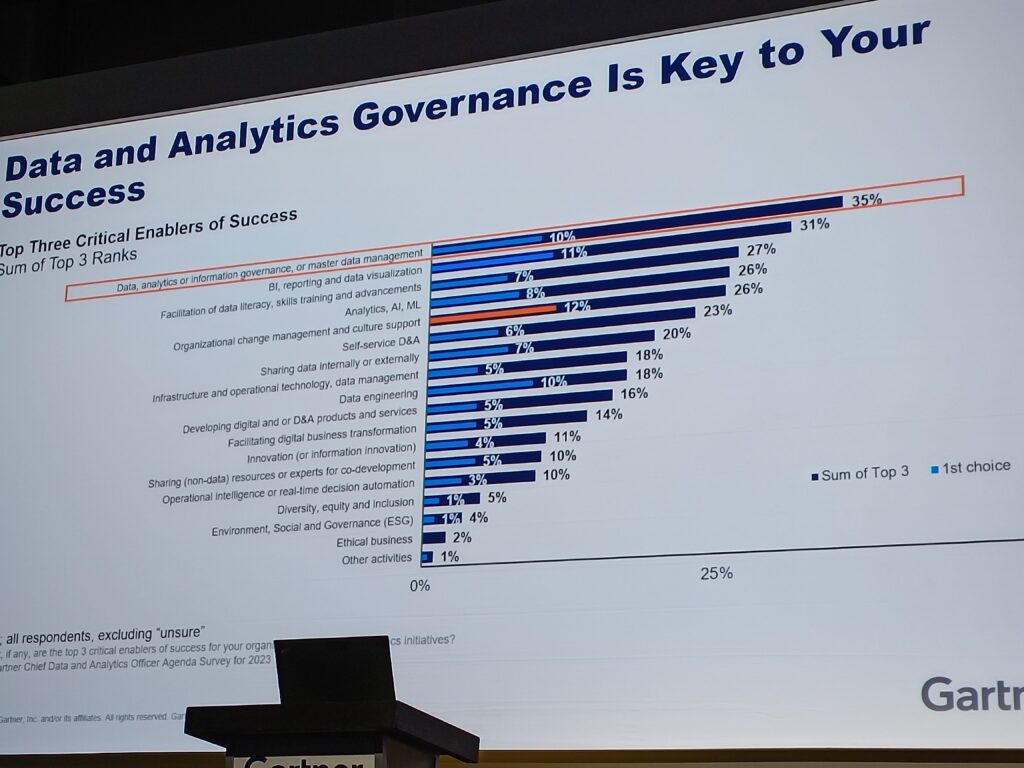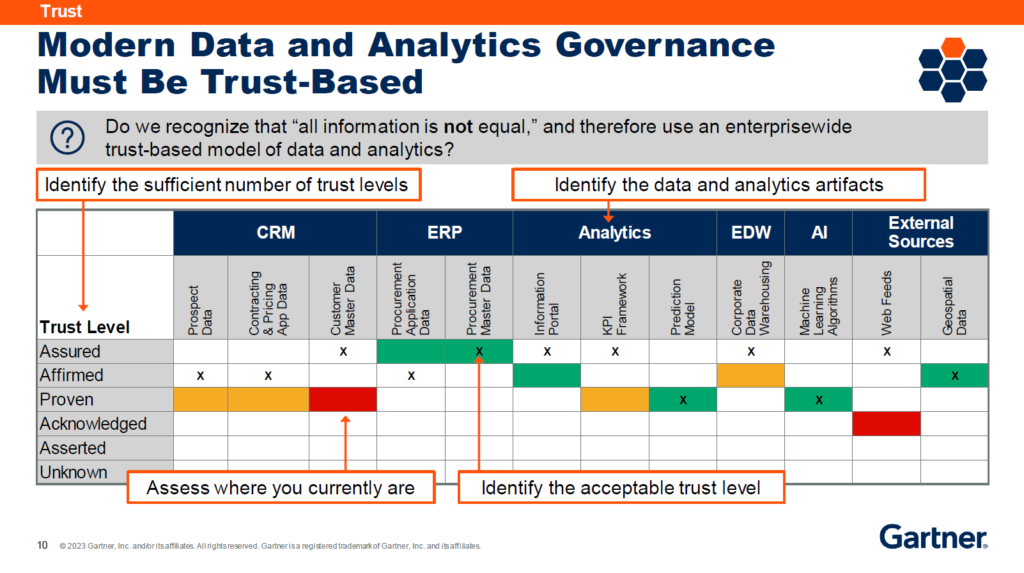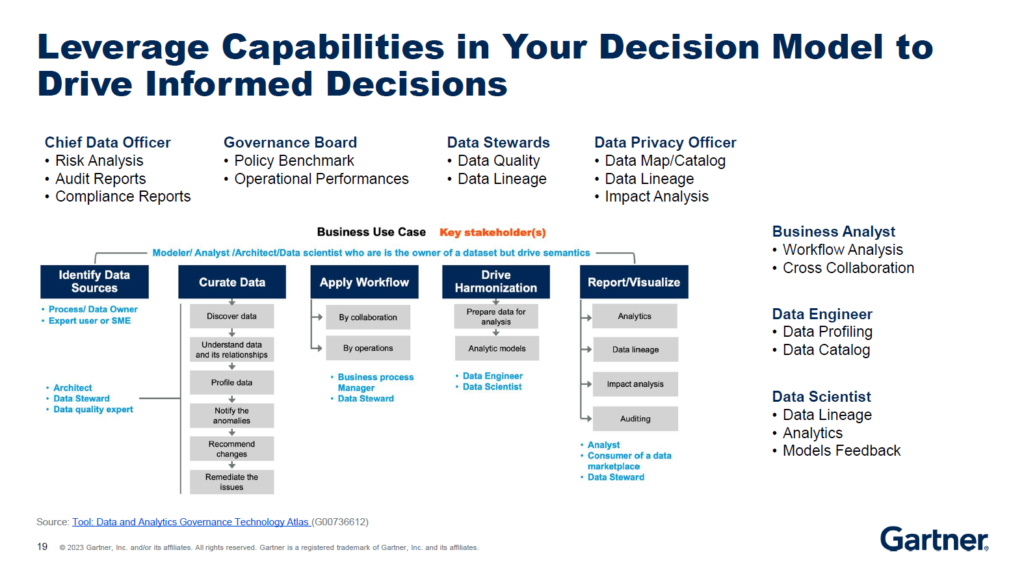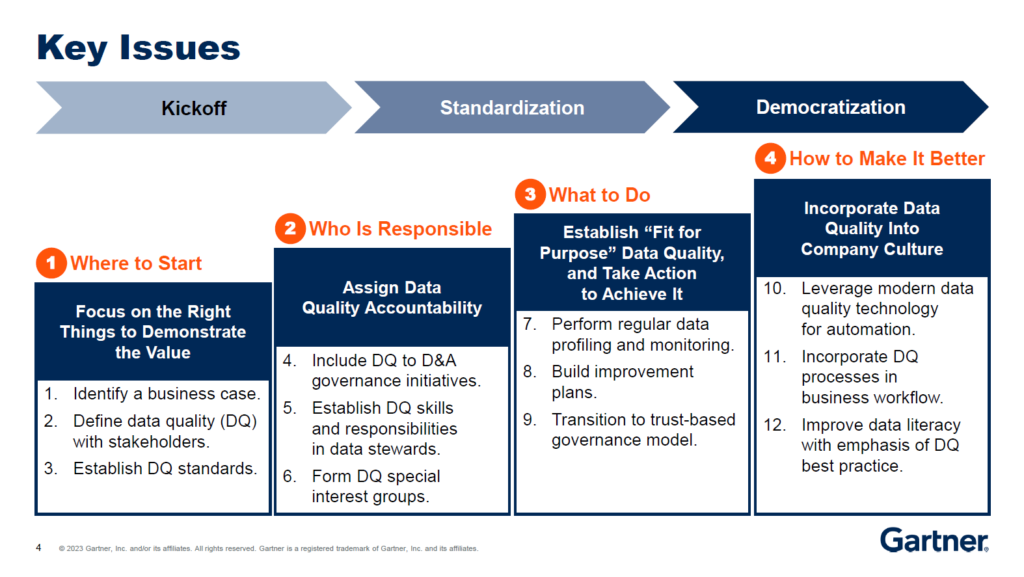
Governance is Even a Hotter Topic in the Era of ChatGPT
My Impressions and Perspectives on the Gartner® Data & Analytics Summit 2023 – Part 2.
Contents of this blog series:
- Lead for Purpose. Connect with Trust. Make an Impact.
- Governance is Even a Hotter Topic in the Era of ChatGPT, and 12 Steps to Address Data Quality for Good.
- Data Lake / Mesh / Data Fabric and Everything in Between (The Active Metadata).
In the first part of this blog series, I pointed to the recurring theme in the Summit of Trust and how it was connected to decision-making and collaboration. Trust is even more important in the era of Generative AI tools like ChatGPT, as I covered in a previous blog. How do we increase and facilitate trust in organizations and between organizations? That’s right, Governance!
If you want to learn from Gartner about Governance trends in Data and Analytics – Saul Judah is the person you want to meet with. I believe he is one of the leading experts in the field. Naturally, Saul’s session “Data and Analytics Governance: Foundations and Prospects” [1] was high on my list to attend during the summit.
He opened with the acknowledgment that Governance was still the number #1 success enabler of D&A initiatives.

The possible reason for that is that policies are enablers of behavioral change, and clearly, we need a change of behaviors: even though 73% of organizations report a high degree of support and investment in Governance initiatives, success is still limited, mostly on the compliance side. According to the “Seven Must-Have Foundations for Modern Data and Analytics Governance,” control (or – insistence on compliance for its own sake) achieves a Governance maturity score of less than 2.1, whereas control with outcome moderation, agility, and autonomous governance, scores above 3.5 on the maturity index. This is the Governance we need, according to Saul Judah.
How do we define the Governance we need, the type that drives desired behaviors? Saul defines Data and Analytics Governance as “the specification of decision rights and accountability framework to ensure appropriate behavior in the valuation, creation, consumption, and control of data and analytics.”
Accordingly, how do we define success? Is it Trust? Or Collaboration? The KPIs pyramid that details outcomes from data quality to efficiency to strategy confirmation shows us different success criteria for different stakeholders:

If all these roles are in your Governance Board, they can drive decisions into processes and business context. Think about a “data office” that coordinates and facilitates support between a stewards council, a Business Governance board, and various process owners for all Governance initiatives.
Another aspect of a successful Governance process is understanding the nature of the data and analytics assets: define the levels of acceptable trust for each type of asset after considering its importance and sensitivity level. It can be acceptable for some organizations that their CRM dataset is less secure than the dataset used for AI models, for other organizations – CRM security is their highest priority.

Besides considering sources of assets, how do we define acceptable levels of Trust? Opportunity vs. Risk appetite! If both are high, the risk can be accepted; if both are low – it is better to avoid risk; in other cases, it is better to mitigate or transfer the risk.
The best candidates for selecting the first Governance stakeholders and Governance Board members are the early adopters. They can be educated, and from enthusiasts, they can become catalysts and ambassadors of Governance as we want to shift from control to collaboration, from bureaucracy to encouraging innovation, to “getting things done” instead of “getting by”.
Finally, these are the questions that D&A Governance we need should answer:
- Do we need to know? (monitoring and self-service)
- Is it safe? (access and security)
- Is it trustworthy? (scoring, certification, data quality, metadata)
- Can this be leveraged? (Reusability and accessibility)
Once we understand what D&A Governance means and how it is implemented and measured, we can see where it fits on the global level of the overall D&A Strategy and Operating Model (“DASOM,” there are many resources on this topic on the Gartner portal). Governance belongs to the ecosystem part. It is the glue between strategy and operation, between objectives to their correct execution. Without Governance, we cannot deliver the strategy.

My take on Saul’s recommendations for D&A Governance success is as follows:
- Use the combination of Gartner’s “IT Score for D&A” and the seven foundational steps described above to evaluate your current Governance practices.
- Learn your organization’s short and long term business strategy, and map the D&A tech and trends from which those strategies could benefit.
- Identify the Governance functionalities required to support those initiatives and choose the technology platform(s) which support your needs.
- Recruit early adopters and turn them into ambassadors and catalysts.
It was only fitting to couple Saul’s session with Thornton Craig’s “Deploy Data and Analytics Governance Effectively to Drive Better Decisions” [2]. This session gave an outlook of a business use case implementation of Governance and the decision-making process that Governance facilitated for different roles within the organization.
In one word – what is the effective method of implementing Governance? Try – contextual!

To be effective, all four pillars of D&A Governance have to be connected to business value and be supported by sufficient tech automation. Tech tools should support activities like identification, curation, workflow, harmonization, and visualization.
Remember the KPIs pyramid from Saul’s session? For Thornton Craig, Governance is the gray arrow top-down from strategic to tactical via operational objectives:

If you consider kicking off the Governance project, answer as many questions as possible on your initiative across strategy/people/metrics/process/infrastructure criteria:
- Is it aligned with the organization’s business strategy?
- Do you have a Governance board? An allocated data steward? Approved funding?
- Do you have defined measurable objectives and targets?
- Are you changing the existing way of doing things?
- What is the existing and /or new tech which can help you to facilitate and automate most of the expected tasks?
Once you have answered those, the next step is correctly identifying the relevant tech capabilities:

Decisions on investment in new tech should be driven by driver and policy, and then translated into tool capability. To avoid silos, bring contextual tools to interconnect the drivers and policies.
Then ask yourself which degree of automation you are prepared for. Is it an augmented catalog you are looking for? A glossary to manage conflicts in definitions? Taxonomy to understand usage? Or maybe stewards and Governance Board to use all of the above? Is it an active metadata tool that will move the needle for you?
After understanding how to set up the D&A Governance process efficiently, let’s explore how it can support organizational decision-making processes.
Informed decisions should be based on the role and tool capabilities:

The roles span from CDO to Data Engineer, and the decision-making spans from risk analysis to data profiling. Regardless of the underlying tech, combine the above-mentioned five activities (identification, curation, workflow application, harmonization, and visualization) with related capabilities on top of whatever you already have.
If you feel that the disciplines above are too advanced for you and are still focusing on data quality – this should be addressed. Data quality is the #1 prerequisite for any D&A initiative, and therefore it was great that Melody Chien presented the session “Twelve Actions to Improve and Sustain Your Data Quality“ [3] with some practical advice.
Melody shared a shocking statistic about the implications of poor data quality.

It is important to note that it doesn’t necessarily mean that poor data quality is always so costly. However, surely most companies can find shocking examples of their own.
Melody suggested undertaking twelve actions across four steps to improve data quality (DQ): where to start, who is responsible, what to do, and how to make it better:

Data Quality is everyone’s job, so subsequently, it becomes no one’s responsibility. To address this, choose your champions and, ideally, if you have resources, start the twelve actions across all four steps at once:
- Identify a business use case (not all data is equally important) – what are the major business outcomes which are influenced by (poor) data quality?
- Find stakeholders from IT, also lean into business functions. Teach them the common language of DQ.
- Identify the most critical DQ issues: usually on the compliance side. Define what is “good enough” for your use cases, re-examine periodically, and analyze the mistake tolerance.
- DQ should be a part of the governance initiative, never handle it separately. Don’t only talk to the governance committee but also engage in dialogue with its business stakeholders.
- Skills: hire data stewards who are skilled in communications and project management, politically savvy, and possess business acumen and data and analytics skills. They will investigate issues and even sometimes solve them; curate and manage metadata; define and monitor rules; and orchestrate DQ best practices.
- DQ interests across business and IT is a team sport. Start from individuals who can benefit the most and showcase success stories to them as well as interest group leaders to spark excitement.
- Data profiling and monitoring: find a tool to quantify your DQ. Monitor anomalies and benchmark grades.
- Build an improvement plan which consists of a short-term analysis, a preventive plan, and remediation tasks.
- Switch from a truth-based model to a trust-based model. Break the trust intro levels (assured, affirmed, proven, acknowledged, asserted, unknown). Define the desired level for each data asset, and prioritize improvement. This was part of Saul’s presentation (discussed above).
- Leverage automation and augmentation: it is impossible to scale otherwise. Active metadata with AI/ML is the tool to look for.
- Incorporate DQ in business workflows. Analyze the frequency of DQ issue occurrences, and address them via a centralized DQ services delivery.
- Data Literacy: embrace a DQ mindset, make people care, and facilitate knowledge transfer.
We are on the brink of the era of Generative AI, with ChatGPT spearheading the evolution under the strong Microsoft brand support. Data Quality and Governance issues must be addressed before applying those advanced Generative AI tools to your data landscape. Otherwise, we will end up with an even more expensive version of “garbage in garbage out.” But it is not enough: you also need to govern how Generative AI tools interpret (or – map) their data models to your own data model – if this mapping is done incorrectly, for example, the vendor accounts are mapped to customer accounts by mistake, we will get wrong results even with the best quality of data. Therefore not only is Governance not going anywhere soon, but it will become an indispensable tool in the near future. However, it must undergo a great degree of automation to tackle those new challenges efficiently. Automating, or at least augmenting, Governance is possible, and one of the methods is activating your Metadata. I’m going to address that later on in this series.
In the first part of the blog, I covered major shifts in the enterprise strategy and operational initiatives. In this blog, I surveyed how Governance prepares enterprises to achieve technological breakthroughs while keeping Quality under control. In the next blog, I will delve into what the data landscape will look like, or “Data Mesh vs. Data Fabric.”
[1] Gartner, “Data and Analytics Governance: Foundations and Prospects,” Gartner Data & Analytics Summit, Orlando, Florida, 20-22 March, 2023.
[2] Gartner, “Deploy Data and Analytics Governance Effectively to Drive Better Decisions,” Gartner Data & Analytics Summit, Orlando, Florida, 20-22 March, 2023.
[3] Gartner, “Twelve Actions to Improve and Sustain Your Data Quality,” Gartner Data & Analytics Summit, Orlando, Florida, 20-22 March, 2023.
* GARTNER is a registered trademark and service mark of Gartner, Inc. and/or its affiliates in the U.S. and internationally and is used herein with permission. All rights reserved.




